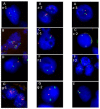Use of Fluorescence In Situ Hybridization (FISH) in Diagnosis and Tailored Therapies in Solid Tumors
- PMID: 32316657
- PMCID: PMC7221545
- DOI: 10.3390/molecules25081864
Use of Fluorescence In Situ Hybridization (FISH) in Diagnosis and Tailored Therapies in Solid Tumors
Abstract
Fluorescence in situ hybridization (FISH) is a standard technique used in routine diagnostics of genetic aberrations. Thanks to simple FISH procedure is possible to recognize tumor-specific abnormality. Its applications are limited to designed probe type. Gene rearrangements e.g., ALK, ROS1 reflecting numerous translocational partners, deletions of critical regions e.g., 1p and 19q, gene fusions e.g., COL1A1-PDGFB, genomic imbalances e.g., 6p, 6q, 11q and amplifications e.g., HER2 are targets in personalized oncology. Confirmation of genetic marker is frequently a direct indication to start specific, targeted treatment. In other cases, detected aberration helps pathologists to better distinguish soft tissue sarcomas, or to state a final diagnosis. Our main goal is to show that applying FISH to formalin-fixed paraffin-embedded tissue sample (FFPE) enables assessing genomic status in the population of cells deriving from a primary tumor or metastasis. Although many more sophisticated techniques are available, like Real-Time PCR or new generation sequencing, FISH remains a commonly used method in many genetic laboratories.
Keywords: ALK; COL1A1-PDGFB; FISH; HER2; ROS1; personalized medicine; personalized oncology; t(X,18); targeted treatment.
Conflict of interest statement
The authors declare no conflict of interest.
Figures

References
-
- Sáez A., Andreu F.J., Baré M.L., Fernández S., Dinarés C., Rey M.J. HER-2 Gene Amplification by Chromogenic in Situ Hybridisation(CISH) Compared with Fluorescence in Situ Hybridisation(FISH) in Breast Cancer—A Study of Two Hundred Cases. Breast. 2006;15:519–527. doi: 10.1016/j.breast.2005.09.008. - DOI - PubMed
-
- Kim H., Yoo S., Paik J., Xu X., Nitta H., Zhang W., Grogan T.M., Choon-Taek L., Sangonhoon J. Detection of ALK Gene Rearrangement in Non-Small Cell Lung Cancer: A Comparison of Fluorescence in Situ Hybridization and Chromogenic in Situ Hybridization with Correlation of ALK Protein Expression. J. Thorac. Oncol. 2011;6:1359–1366. doi: 10.1097/JTO.0b013e31821cfc73. - DOI - PubMed
Publication types
MeSH terms
Substances
Grants and funding
LinkOut - more resources
Full Text Sources
Other Literature Sources
Medical
Research Materials
Miscellaneous

